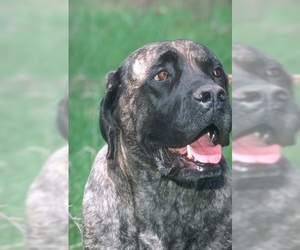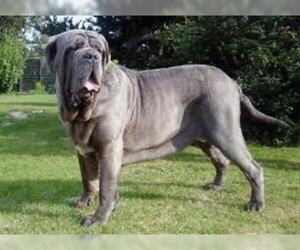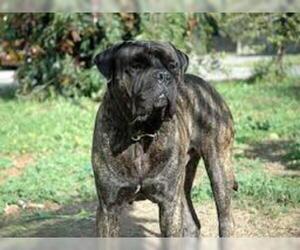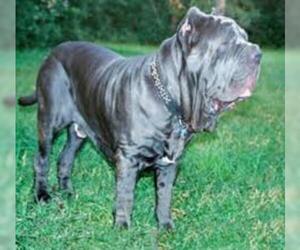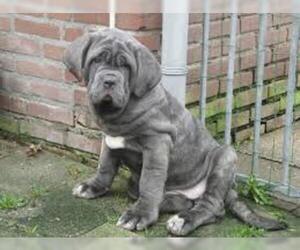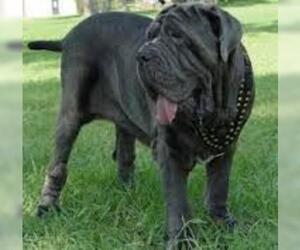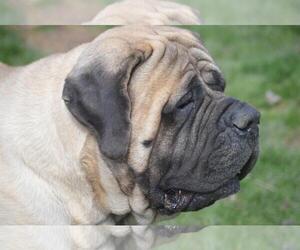
All about Mastiff dog breed
A.K.A. :Old English Mastiff, English Mastiff, Mastiff Dog, Broad-Mouthed Dog, Gentle Giant, Big Dog, Mastiff Type Dog, Mastiff-like Dog, Giant Mastiff, British Mastiff, Mastin Ingles
Size
Grooming requirements
Exercise requirements
Good with other dogs
Watchdog ability
Energetic
Training requirements
Playful
Affectionate
Good with other pets
Good with children
Good with strangers
Winter
Summer
Healthiness
Protective
Life Span
| Pure Breeds | Member |
| Breeds A - Z | M |
| Breeds by Group | Flock Guards & Mastiffs Working |
| Breeds by Trait | Good With Kids Low Shedding |
| Overview: | The Mastiff, an ancient and noble breed, boasts a history stretching back millennia, often linked to the Molosser dogs of antiquity. Renowned for their immense size, these gentle giants are characterized by their powerful, muscular build, broad head, and short, dense coat typically seen in fawn, apricot, or brindle. Despite their imposing appearance, Mastiffs are famous for their remarkably calm and gentle temperament, making them surprisingly affectionate and devoted companions. They generally get along well with children and other pets, provided they are properly socialized from a young age. While their size might suggest a need for vast spaces, their relatively low energy levels mean they can adapt to apartment living if given regular, moderate exercise. Prospective owners should be aware of common health concerns such as hip and elbow dysplasia, bloat, and eye conditions, necessitating responsible breeding and veterinary care. Their loyalty and protective instincts, combined with their loving nature, make the Mastiff a truly magnificent addition to the right family. |
F.A.Q.
All You Need to Know About the Mastiff Breed
The Mastiff, an ancient breed originating from England, is renowned for its dignified and gentle nature, despite its imposing size. These colossal canines are surprisingly affectionate and make excellent, albeit large, family pets, often described as “gentle giants.” While their size might suggest high energy, Mastiffs are generally low-energy dogs, content with moderate daily walks and lounging indoors. They are not ideal for small apartments due to their sheer bulk but can adapt to various living situations with enough space. Their short coat requires minimal grooming, primarily brushing to manage shedding. Potential owners should be aware of common health concerns, including hip and elbow dysplasia, bloat, and eye conditions. Early socialization and training are crucial for managing their size and ensuring they grow into well-behaved companions. Their loyalty and protective instincts make them good guardians, always gentle with their loved ones.Mastiff Weight: Understanding the Average SizeThe average Mastiff weight for an adult typically falls between 120 and 230 pounds. This impressive size makes them one of the largest dog breeds.* Male Mastiffs are generally heavier, ranging from 160 to 230 pounds.* Female Mastiffs are usually a bit lighter, with a healthy weight for Mastiff females typically between 120 and 170 pounds.This information provides a good guide for the average size and healthy weight for Mastiff adults. Remember, individual weights can vary based on genetics, diet, and activity level.
How tall is a Mastiff? What's the average height of a Mastiff?
When considering a majestic Mastiff, their impressive size is often a key characteristic. The average height of a Mastiff, measured at the shoulder (or withers), typically falls within the range of 27 to 30 inches. This makes them one of the tallest dog breeds, contributing to their imposing yet gentle presence.While 27 to 30 inches is the general guideline, there can be some variation:- Males (Dogs): Male Mastiffs generally stand at the taller end of this spectrum, often reaching 29 to 30 inches in height.
- Females (Bitches): Female Mastiffs are typically a little shorter, usually ranging from 27 to 29 inches at the shoulder.
The Mastiff colors officially recognized by major kennel clubs like the AKC are fawn, apricot, and brindle. Fawn Mastiffs are typically a light tan or beige color, while apricot Mastiffs display a richer, more reddish-tan hue. Brindle Mastiffs feature a striking pattern of dark stripes over a fawn or apricot base, often described as a tiger-stripe effect. All accepted colors should have a dark mask on the muzzle, ears, and around the eyes.While not officially recognized by the AKC, some exotic Mastiff variations and rare coat types exist due to specific genetics or crossbreeding. These include cream, white, blue (diluted black), lilac (diluted chocolate), chocolate, and merle. It's important to note that these uncommon Mastiff colors may not be accepted for conformation showing by the AKC or other breed clubs and puppies with these rare Mastiff colors may carry a different price point due to their unique appearance or breeding practices. When considering Mastiff coat types, always prioritize health and temperament, regardless of color.
The Mastiff personality is characterized by a noble, gentle, and devoted nature. Known for their calm demeanor, they are incredibly loyal to their families and form strong bonds, often displaying an affectionate and patient temperament. While generally friendly with their own "pack," their sociability with strangers can be reserved; they are excellent guardians who are naturally protective without being overtly aggressive. Adaptability to apartment living is possible given sufficient exercise and mental stimulation, but a larger home with a yard is often preferred due to their size. They are typically good with children they are raised with, exhibiting a gentle giant quality, though supervision is always advised due to their sheer size. With other pets, early socialization is key, and they can coexist peacefully, especially if introduced as puppies. Their temperament of Mastiff makes them wonderful companions for those seeking a loving, watchful, and stately canine friend.
The Mastiff temperament is generally described as gentle, devoted, and courageous. They are known for their calm and watchful nature, making them excellent, if large, companion dogs.
Friendliness & Sociability: Mastiffs are typically very friendly with their own family and those they know. While not overtly boisterous, they display deep affection. They can be reserved with strangers, demonstrating a protective instinct, but are rarely aggressive without cause. Early socialization is crucial to ensure they are well-adjusted.Loyalty & Adaptability: Expect unwavering loyalty to their human family. They thrive on companionship and prefer to be involved in family activities. Despite their size, they are surprisingly adaptable to apartment living provided they receive adequate daily walks and mental stimulation. They are not high-energy dogs, preferring to lounge near their people.Behavior with Children & Other Pets: With proper introduction and supervision, Mastiffs are generally good with children, exhibiting a patient and protective demeanor. However, due to their sheer size, supervision with very young children is always recommended to prevent accidental tumbles. Many Mastiffs can also live peacefully with other pets, especially if raised with them, though individual personality traits can vary.Stubbornness & Sensitivity: While intelligent, Mastiffs can possess a moderate degree of stubbornness, requiring consistent and positive reinforcement training. They are also quite sensitive and do not respond well to harsh correction; gentle guidance and praise are far more effective in shaping their behavior.Mastiff Care: Daily Maintenance & Health TipsMastiff care is relatively straightforward for this gentle giant, though their size demands specific attention. Grooming needs are minimal; a weekly brush for their short coat, increasing during shedding season, is usually sufficient. Regular nail trims are crucial for comfort and preventing splayed feet.Exercise limitations are important to understand. Mastiffs are a low-energy dog breed and prone to overheating. Short, leashed walks several times a day are ideal, avoiding strenuous activity, especially in warm weather. Puppies need controlled exercise to protect developing joints.Dietary considerations are paramount for healthy growth and preventing obesity. Feed a high-quality, large-breed dog food formulated for their age and activity level. Monitor portion sizes closely to avoid rapid growth in puppies and weight management issues in adults. Bloat (gastric torsion) is a serious risk; feeding smaller, more frequent meals and avoiding exercise directly after eating can help.Wrinkle and ear cleaning are essential. Regularly clean facial wrinkles with a damp cloth to prevent skin infections and irritation. Their pendulous ears require weekly cleaning to prevent wax buildup and infections.Climate sensitivity due to brachycephalic anatomy means Mastiffs struggle in heat and humidity. They are prone to heatstroke due to their short snouts. Provide ample shade, fresh water, and avoid exercise during peak temperatures. They also require indoor living as they are not suited for extreme cold.Common health concerns include hip and elbow dysplasia, heart conditions, bloat, and certain cancers. Skin issues can arise in their wrinkles if not properly cleaned. Regular dental care (brushing and professional cleanings) is vital to prevent gum disease and tooth decay. Regular vet check-ups are key for early detection and preventative care. How to care for a Mastiff effectively involves understanding these specific needs to ensure a long, healthy life for your gentle companion.
Mastiff Activity Level: How Active Are Mastiff?The Mastiff activity level is generally considered low to moderate. While they are large dogs, their energy levels are surprisingly mellow, making them an excellent choice for individuals or families seeking a more relaxed companion.Typical Energy Levels: Mastiffs are known for their calm and placid demeanor. They enjoy a good balance of short bursts of playful energy followed by long periods of rest. Don't let their size fool you; they aren't built for marathons! Their ideal day often involves some gentle playtime, a walk, and plenty of napping.Daily Exercise Needs: To maintain a healthy weight and mental well-being, Mastiff exercise needs are moderate. Two to three short to medium walks daily (15-30 minutes each) are typically sufficient. They also enjoy some supervised outdoor playtime in a securely fenced yard. Avoid intense or prolonged exercise, especially during hot weather.Playtime Preferences: Mastiffs enjoy interactive playtime, but it's usually low-impact. Tug-of-war (with caution for their joints), gentle fetch with soft toys, and puzzle toys are good options. They are not high-intensity fetch players who will tirelessly retrieve for hours.Limitations Due to Brachycephalic Anatomy: As a brachycephalic (short-nosed) breed, Mastiffs have specific limitations. They are prone to overheating and can experience breathing difficulties during strenuous activity or in warm temperatures. Always monitor them closely for signs of distress like excessive panting or labored breathing. Exercise should be kept short and gentle, especially in heat or humidity, and they should always have access to fresh water and shade.Suitability for Families: Mastiffs are suitable for low-energy households or families who appreciate a calm, gentle giant. They are not ideal for highly active families seeking a dog to accompany them on long runs, hikes, or intense sporting activities. Their contentment comes from being with their people, even if it's just lounging on the couch.
Breed Breakdown: What Experts Say About the Mastiff
The Mastiff breed rates a 10 on the "Size" trait.This breed is undeniably massive. Adult Mastiffs typically stand between 27 and 30 inches tall at the shoulder, with some males reaching even greater heights. Their weight can range from 160 to 230 pounds, and some individuals have exceeded this, making them one of the heaviest dog breeds. Their body structure is broad, muscular, and substantial, giving them a truly imposing presence. When compared to most other companion dog breeds, even large ones, the Mastiff dwarfs them in every dimension.Due to their colossal size, Mastiffs are not well-suited for apartment living, frequent travel, or households with significant space constraints. They require ample indoor and outdoor space to move around comfortably and stretch out without feeling confined. While their temperament is generally gentle, their sheer bulk necessitates a home environment that can accommodate their physical needs.
I would rate the grooming requirements of a Mastiff a 4 out of 10.While their short coat might suggest lower maintenance, they are not entirely wash-and-go. Their shedding frequency, especially seasonally, is moderate and requires regular brushing to keep it under control and prevent hair from accumulating. The most significant factor contributing to their slightly higher rating compared to a truly low-maintenance breed is the necessity for consistent care of their skin folds, particularly around the face and jowls. These folds can trap moisture and debris, making them susceptible to irritation and infection if not cleaned regularly. While not every Mastiff will have severe skin fold issues, it's a common enough concern to warrant ongoing attention. Their large, floppy ears also need routine checking and cleaning to prevent wax buildup and potential infections. Nail trimming is essential due to their size, and bathing needs are moderate, though a good scrub is required for their often drooly and messy nature. They can also be prone to some skin sensitivities, requiring careful product selection. Overall, while not extremely high-maintenance like a long-haired or curly-coated breed, they do require consistent and specific attention to certain areas to ensure their health and comfort, making them more involved than an extremely easy-care dog.
I would rate the "Exercise Requirements" of the Mastiff breed at a 3 out of 10.While Mastiffs are large dogs and need some activity to maintain muscle tone and prevent obesity, their energy levels are remarkably low. They are generally content with a couple of short, leisurely walks per day (20-30 minutes each) and some supervised playtime in a secure yard. Sustained movement is not their strong suit; they tire relatively quickly and are prone to overheating, especially given their brachycephalic anatomy which can make breathing more challenging during exertion. Activities like agility or long-distance running are unsuitable and could be detrimental to their health. They thrive with minimal, consistent activity rather than demanding, structured routines. Mental stimulation is more about interaction and gentle play than intense physical challenges.
I would rate the Mastiff's "Watchdog Ability" at a 7 out of 10.While not a constant barker or overtly aggressive, the Mastiff is far from a passive companion. Their sheer size and imposing presence are often enough to deter most casual intruders. They are highly alert within their home environment and possess strong territorial instincts, especially when it comes to their family. They will certainly respond to unfamiliar sounds or people with a deep, resonant bark, which serves as an excellent early warning system. This bark is not typically incessant but rather a deliberate signal of perceived intrusion. What they lack in frantic energy, they make up for in gravitas; an intruder would be faced with a massive, watchful dog whose intent gaze and low growl are clear indicators that they are unwelcome. While they are not generally attack dogs, their loyalty and protective nature mean they are willing to stand their ground and deter threats, making them effective for providing meaningful early warnings and a formidable visual deterrent.
I would rate the "Good with Other Dogs" trait of the Mastiff breed a 5 out of 10.Mastiffs are generally known for their calm and gentle demeanor, but their historically protective nature and immense size can lead to complexities in multi-dog environments. When properly socialized from a young age, many Mastiffs can coexist peacefully with other dogs, especially those they've grown up with or familiar canine companions. However, their lower energy levels often mean they don't appreciate boisterous or overly playful dogs, and their sheer size can unintentionally intimidate or injure smaller, more fragile breeds if interactions aren't carefully supervised. They can also exhibit a strong prey drive towards much smaller, fast-moving animals if not desensitized. Dominance issues can arise with same-sex dogs, particularly intact males, and their natural guardian instincts can lead to protectiveness over their home or family members, potentially manifesting as aggression towards unfamiliar dogs entering their space. Therefore, while not inherently aggressive, their compatibility with other dogs heavily relies on extensive, positive socialization, careful introductions, and consistent training to ensure peaceful coexistence and prevent potential conflicts, making them a breed that requires thoughtful management rather than one that naturally thrives in all canine company without effort.
I would rate the "Energetic" trait of the Mastiff breed a 2 out of 10.The Mastiff is a prime example of a giant breed with a remarkably low energy level. They are renowned for their laid-back, "couch potato" demeanor and are far from naturally active. While puppies may have short bursts of playfulness, adult Mastiffs are generally content with short, leisurely walks and spending the majority of their day napping or lounging. Their endurance is quite limited; they tire easily and are not built for sustained physical activity.Their brachycephalic (short-nosed) anatomy significantly impacts their stamina and exercise tolerance. This facial structure can make breathing more difficult, especially during exertion or in warm weather, leading to a higher risk of overheating and respiratory distress. Consequently, they are not suited for strenuous outdoor or athletic activities and require careful monitoring to prevent overexertion, even during moderate exercise. Compared to most other companion dogs, the Mastiff is decidedly more tranquil and prefers a calm, unhurried pace of life.
I'd rate the Mastiff's "Training Requirements" at a 6 out of 10. While not inherently difficult or unintelligent, they aren't a breed that trains itself. Their intelligence is present, but often overshadowed by a significant stubborn streak and a preference for comfort over immediate obedience. Their attention span can be surprisingly short, especially if they deem a task repetitive or uninteresting. Responsiveness to commands requires consistent reinforcement and patience, as they can be quite thoughtful (or slow) in their reactions.The Mastiff absolutely thrives on consistency and a structured routine; deviation from this can lead to them testing boundaries. Positive reinforcement is highly effective, as they are sensitive souls and respond poorly to harsh methods. Food motivation, in particular, can be a powerful tool.This breed is not entirely beginner-friendly in the sense that they will roll over and learn everything instantly. A beginner willing to invest time, research positive training methods, and remain incredibly consistent will succeed. However, their sheer size and potential for stubbornness mean that a more experienced owner will likely find the training process smoother and potentially faster, understanding the nuances of their "gentle giant" personality and how to motivate them effectively. Without proper training and socialization from a young age, their size alone can make them unmanageable, highlighting the importance of early and consistent effort.
I'd rate the "Playful" trait of the Mastiff breed a 3 out of 10.While Mastiffs are undoubtedly affectionate and enjoy their human companionship, they are generally far from being high-energy or demonstratively playful. Their activity level is quite low; they much prefer lounging and napping to running and jumping. Their love for games and interaction is often limited to a few brief bursts of enthusiasm, and they can tire of it quickly. Attention-seeking behavior is usually expressed through leaning, nudging, or a deep sigh, rather than boisterous antics. Response to toys and playtime is typically moderate at best; they might briefly mouth a toy or engage in a slow game of tug, but intense retrieving or sustained play sessions are rare. Their overall enthusiasm in daily life is characterized by a calm, watchful demeanor. Compared to other companion dogs, they are decidedly more laid-back and reserved, exhibiting a gentle, stoic nature rather than a naturally spirited one.
I'd rate the Mastiff's "Affectionate" trait a solid 9 out of 10.While their immense size might suggest a more independent nature, Mastiffs are incredibly loving and people-oriented giants. They crave human companionship and form deep bonds with their families. They are well-known for their desire for physical closeness, often trying to be lap dogs despite their considerable weight – a "lean" or a gentle nudge for attention is common. Their loyalty is unwavering, and they are highly sensitive to their owner's emotions, offering a comforting presence when needed. It's not uncommon for a Mastiff to follow their family members from room to room, just wanting to be in the same space. This breed absolutely thrives on affection and considers themselves an integral, cherished part of the family, making them far from independent compared to other companion dogs; they truly live to be with their people.
I would rate the "Good with Other Pets" trait of the Mastiff breed a 7 out of 10.While Mastiffs are generally known for their gentle and calm nature, making them surprisingly adaptable to multi-pet households, this isn't an entirely natural "set it and forget it" trait. Their large size and powerful build mean that even playful interactions can accidentally overwhelm smaller animals, and their inherent protective instincts can sometimes manifest as resource guarding if not properly managed. While their prey drive is typically low, especially towards animals they've grown up with, early and ongoing socialization is absolutely crucial. They generally do well with other dogs, often enjoying their company, but careful introductions and supervision are key to ensure their immense size doesn't intimidate or accidentally injure smaller canines. With cats, their calm demeanor often allows for peaceful coexistence, particularly if introduced as a puppy. However, their tendency towards being "one-person dogs" can sometimes extend to resource guarding their human from other pets, requiring consistent training to establish clear boundaries. Therefore, with proper training, socialization from a young age, and continued supervision, a Mastiff can be an extremely pet-friendly companion, but it's not an inherent trait that requires no effort.
The Mastiff breed rates a 7 out of 10 for "Good with Children."This rating reflects the breed's generally calm, patient, and gentle nature. Mastiffs are renowned for their protective instincts, which often extend to the children in their family, making them watchful and devoted guardians. They typically have a high tolerance for noise and the sometimes clumsy handling of younger children, displaying remarkable patience. Their sheer size, while initially intimidating, often contributes to a serene demeanor; they aren't prone to frantic movements or aggressive play that could inadvertently harm a child. They are naturally affectionate with their families and thrive on companionship.However, the rating isn't higher due to a few crucial considerations. Their immense size and strength mean that even accidental bumps or knocks can be significant for a small child. While generally not playful in a boisterous sense, their weight requires constant supervision, especially with toddlers, to prevent accidental trampling or knocking over. Furthermore, like all large breeds, early socialization and consistent training are essential to ensure they understand boundaries and respect children. While naturally gentle, a poorly socialized or untrained Mastiff could be a liability simply due to its power. They are more "gentle giants" who will tolerate children rather than actively engage in energetic play, which might not suit families seeking a highly playful canine companion. Therefore, while suitable and often wonderful with children, they require responsible ownership and supervision to thrive safely in a family setting.
I would rate the "Good with Strangers" trait of the Mastiff breed a 5.While not inherently aggressive, Mastiffs are typically reserved and protective, falling squarely in the middle of the spectrum. They are not naturally outgoing and will not greet every new person with an an exuberant wag. Instead, their default is to observe and assess unfamiliar adults. This isn't necessarily unfriendly, but rather a cautious, watchful demeanor. They are inherently guardians and their large size and calm presence can be intimidating even if they're not actively barking or displaying overt guarding behaviors.With proper, early, and consistent socialization, a Mastiff can become quite comfortable and accepting of strangers, particularly in environments where they feel secure and with people their owner has welcomed. Without this foundational training and exposure, they can be aloof, preferring to keep their distance, and may even appear standoffish or unwelcoming. While they are adaptable to public environments, their natural inclination is to be a watchful presence rather than a social butterfly. They are unlikely to be overly barky unless they perceive a genuine threat, but their mere presence often conveys a message of "approach with caution." They require training and positive experiences to shift from their natural guardedness to a more accepting, though still reserved, demeanor around unfamiliar individuals.
I would rate the Mastiff's "Winter" tolerance at a 2.This breed possesses several characteristics that make them highly sensitive to cold weather. Their short, dense coat offers minimal insulation against low temperatures. While their large body mass and relatively high body fat can provide some degree of thermal regulation, it's insufficient to counter significant cold. Their brachycephalic (short-nosed) anatomy further exacerbates their vulnerability, making them less efficient at warming inhaled air, which can lead to respiratory issues and discomfort in cold, dry conditions. They are at a heightened risk of hypothermia, particularly during prolonged exposure or in very low temperatures, and their joints can become stiff and painful in the cold. Consequently, Mastiffs absolutely require special care during winter months compared to many other companion dogs. They should not be left outdoors in cold weather, require warm indoor shelter, and often benefit from protective outerwear like coats or sweaters when venturing outside for short periods. Their outdoor activity should be limited and carefully monitored to prevent cold-related illnesses and discomfort.
I would rate the "Summer" tolerance of the Mastiff breed as a 2.Mastiffs are highly sensitive to heat, primarily due to their brachycephalic (short-nosed) anatomy. This characteristic significantly impairs their ability to efficiently cool themselves through panting, making them extremely susceptible to overheating. Their large body mass also contributes to difficulty in regulating body temperature. They are at a very high risk of heatstroke, even with moderate exercise or exposure to warm temperatures. During summer months, Mastiffs require extensive special care compared to most other companion dogs, including limited outdoor activity, especially during the hottest parts of the day, constant access to air conditioning or other forms of climate control, and vigilant monitoring for any signs of heat stress. They are not a breed that can comfortably enjoy typical summer outdoor activities without significant precautions.
I would rate the Mastiff breed's "Healthiness" trait a 4 out of 10.While a well-cared-for Mastiff from responsible breeders can certainly live a good life, they are far from being a robust, low-maintenance breed when it comes to health. This rating reflects their significant genetic predispositions to a multitude of serious health issues. Their giant size contributes to many problems, notably severe joint problems like hip and elbow dysplasia, as well as osteosarcoma (bone cancer), which is a tragically common and aggressive disease in the breed. They are also prone to bloat, a life-threatening gastric condition, and eye issues such as progressive retinal atrophy and entropion/ectropion. Furthermore, their large folds of skin can lead to skin infections if not meticulously maintained, and their sheer size places a considerable strain on their heart, making them susceptible to various cardiac conditions. Their overall life expectancy is notably shorter than many other breeds, often only 6-10 years, which is a strong indicator of their inherent health challenges. While responsible breeding and diligent preventive care, including specialized diets, joint supplements, and regular veterinary check-ups, can mitigate some risks and improve their quality of life, they do not erase the fundamental genetic vulnerabilities. Compared to many other companion dogs, the Mastiff is decidedly high-maintenance in terms of health, often requiring significant financial and emotional investment in their veterinary care throughout their lives.
I would rate the "Protective" trait of the Mastiff breed at a 9 out of 10.Mastiffs are renowned for their protective nature, a trait deeply ingrained in their historical role as guard dogs. Their sheer size and imposing presence are often enough to deter potential threats. They exhibit high alertness, constantly aware of their surroundings, and possess strong territorial instincts, perceiving their home and family as their domain to safeguard. Their loyalty to their owners is unwavering, forming a powerful bond that fuels their desire to protect. While generally calm and gentle with their own family, their reaction to strangers is typically cautious and reserved; they will observe intently and may place themselves between their family and an unfamiliar person. They are excellent watchdogs, alerting with a deep, resonant bark, and are certainly capable of offering meaningful protection in a household setting, not just through their presence but also through their willingness to act if they perceive a genuine threat. While they are undoubtedly cherished companions within their families, their protective instincts and capabilities far exceed that of a typical companion dog, making them formidable guardians.
I would rate the "Life Span" trait of the Mastiff breed a 3.Mastiffs are unfortunately considered a short-lived breed compared to most other companion dogs. Their average life expectancy typically ranges from 6 to 10 years, with many individuals falling closer to the lower end of that spectrum. This is significantly shorter than the 10-13 year average for many medium-to-large breeds and the 12-15+ years seen in smaller dogs. They are genetically predisposed to several health issues common in giant breeds, including bloat (gastric dilatation-volvulus), various cancers (osteosarcoma, lymphoma), heart conditions (dilated cardiomyopathy), and orthopedic problems (hip and elbow dysplasia, osteochondrosis dissecans). While responsible breeding practices, quality nutrition, appropriate exercise, and proactive veterinary care can certainly contribute to a healthier and potentially longer life for an individual Mastiff, these efforts primarily aim to help them reach the upper end of their breed's typical range rather than significantly extending it beyond what is inherently short for a dog. They are unequivocally a short-lived breed.
Mastiff Puppies for saleSee all puppies for sale
Mastiff Dogs for adoptionSee all dogs for adoption
Mastiff BreedersSee all breeders
Similar Dog Breeds for Mastiff
Breed Mixes of Mastiff
Quick Breed Selector 0 - not important, 1 - smallest, 10 - largest
Variants & Mistakes :Massif, Mastif, Masstiff, Mastiffes, Masstif, Mastiffs, Mestiff, Mustiff, Mastiffe, Mastief, Mastife, Mastiffd, Matiff, Mistiff, Mostiff, Mastuff, Msstiff, Tastiff, Yastiff, Lastiff, Ostiff, Pastiff, Restiff, Wstiff, Zastiff, Nastiff, Qastiff, Vastiff, Gastiff, Castiff, Xastiff, Bastiff, Datiff, Eatiff, Fatiff, Hatiff, Iatiff, Jatiff, Katiff, Latiff, Oatiff, Patiff, Ratiff, Satiff, Tatiff
